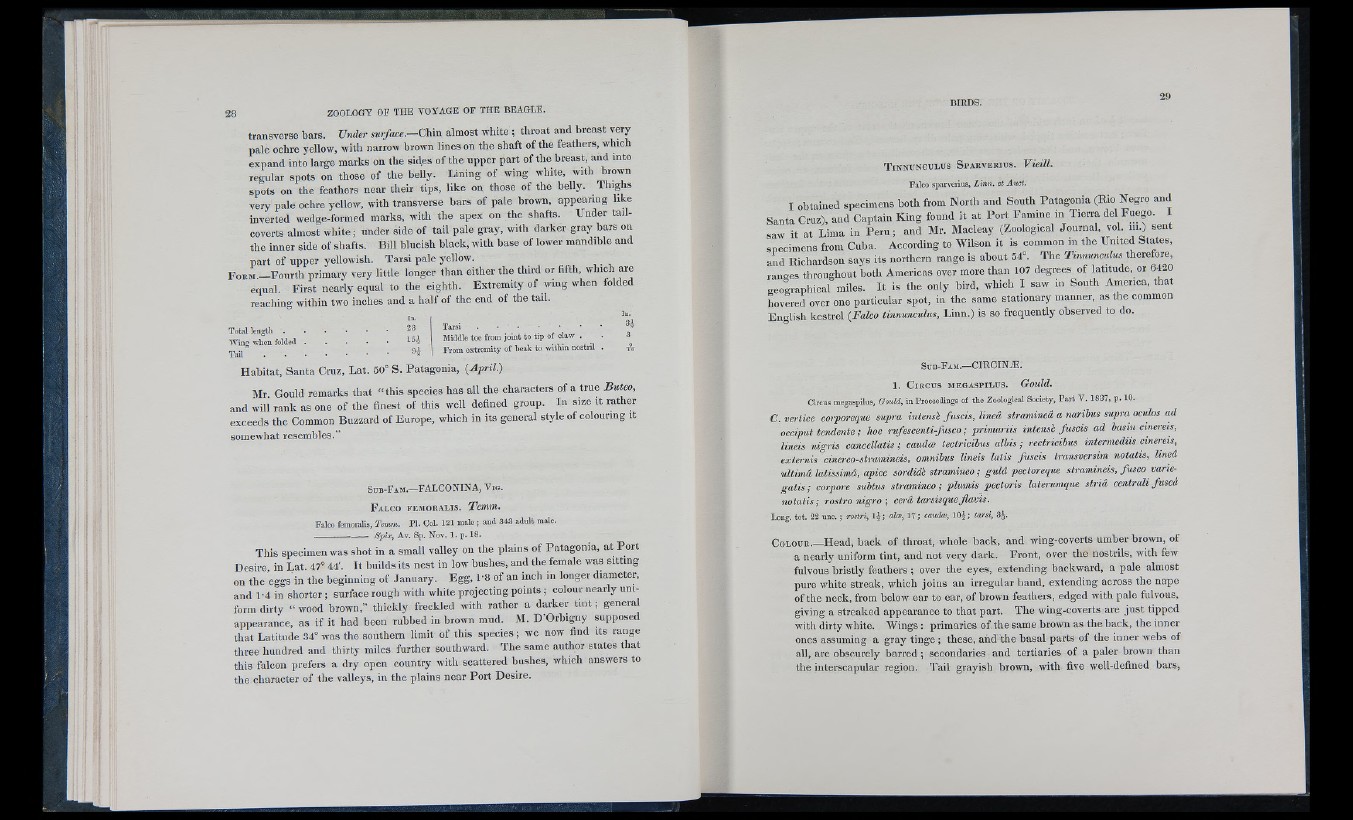
transverse tars. Under ,« ,/a c c .-C h in almost white ; throat and breast very
pale ochre yellow, with narrow brown lines on the shaft of the feathers, which
expand into large marks on the sije s of the upper part of the breast, and into
regular spots on those of the belly. Lining of wing white, with brown
spots on the feathers near their tips, like on those of the belly. Thighs
very pale ochre yellow, with transverse bars of pale brown, appearing like
inverted wedge-formed marks, with the apex on the shafts. Under tail-
coverts almost white; under side of tail pale gray, with darker gray bars on
the inner side of shafts. Bill blueish black, with base of lower mandible and
part of upper yellowish. Tarsi pale yellow.
F o r m .— Fourth primary very little longer than either the third or fifth which are
equal. First nearly equal to the eighth. Extremity of wing when folded
reaching within two inches and a half of the end of the tail.
Total length .
Wing -when folded
Tail
Tarei .........................................
Middle toe from joint to tip of claw .
From extremity of beak to within nostril
3 i
3
*
Habitat, Santa Cruz, Lat. 50” S. Patagonia, {April.)
Mr. Gould remarks that “ this species has all the characters of a true Buteo,
and will rank as one of the finest of this well defined group. In size it rather
exceeds the Common Buzzard of Europe, which in its general style of colouring it
somewhat resembles.”
S u b - F a m .—FALCONINA, V ig .
F a l c o f e m o r a l i s . Temm.
Falco femoralis, T m . PI. Col. 1 2 1 male ; and 343 adult male.
--------------------S pix, A t . Sp. N o t . 1 . p. 1 8 .
This specimen was shot in a small valley on the plains of Patagonia, at Port
Desire in Lat. 47' 44’, It builds its nest in low bushes, and the female was sitting
on the 'eggs in the beginning of January. Egg, 1 '8 of an inch in longer diameter,
and 1-4 in shorter; surface rough with white projecting points ; colour nearly uniform
dirty “ wood brown,” thickly freckled with rather a darker tin t; general
appearance, as if it had been rubbed in brown mud. M. D ’Orhigny supposed
that Latitude 34” was the southern limit of this species; we now find its range
three hundred and thirty miles further southward. The same author states that
this falcon prefers a dry open country with scattered bushes, which answers to
the character of the valleys, in the plains near Port Desire.
BIRDS,
T i n n u n c u l u s S p a r v e r i u s . Vieill.
Falco sparverius, L inn, et Auct.
I obtained specimens both from North and South Patagonia (Rio Negro and
Santa Cruz), and Captain King found it at Port Famine in Tierra del Fuego. I
saw it at Lima in Pern; and Mr. Macleay (Zoological Journal vol. inO sent
snecimens from Cuba. According to Wilson it is common in the United States,
and Richardson says its northern range is about 54”. The Tinnnneidus therefore
ranues tlirougliout both Americas over more than 107 degrees of latitude, or 6420
geographical miles. It is the only bird, which I saw in South America, that
hovered over one particular spot, in the same stationary manner, as the common
English kestrel {Falco timmncnlus, Linn.) is so frequently observed to do.
S u b - F a m .— CIECINÆ.
1 . C i r c u s m e g a s p i l u s . Gould.
Circus megaspilus, Gould, in Proceediugs of the Zoological Society, P art V. 1837, p. 10.
C. vertice corporeque supra intensé fuscis, lined stramined a narilus supra oculos ad
occiput tendente ; hoc rufescenti-fusco ; primariis intensé fuscis ad hasm anereis,
lineis nigris cancellatis ; caudæ tectricilus albis ; rectricibus intermediis ciñereis,^
exlernis cinereo-stramineis, omnibus lineis latis fuscis transversim notatis, lined
ultima latissima, apice sordiié stramineo ; guld pectoreque stramineis, fusco varie-^
g a lis; corpore subtus stramineo; plumis pectoris laterumque stria centrali fusai
notatis ; rostro nigro ; ceì'à tarsisque Jiavis.
Long. tot. 22 uno. ; rostri, 17 1 caudæ, 1 0 |; tarsi, 8¿.
C o l o u r .— Head, back of throat, whole hack, and wing-coverts nmher brown, of
a nearly uniform tint, and not very dark. Front, over the nostrils, with few
fulvous bristly feathers ; over the eyes, extending backward, a pale almost
pure white streak, which joins an irregular band, extending across the nape
of the neck, from below ear to ear, of brown feathers, edged with pale fulvous,
giving a streaked appearance to that part. The wing-coverts are just tipped
with dirty white. Wings : primaries of the same brown as the back, the inner
ones assuming a gray tinge ; these, and the basal parts of the inner webs of
all, are obscurely barred ; secondaries and tertiaries of a paler brown than
the interscapular region. Tail grayish brown, with five well-defined bars,